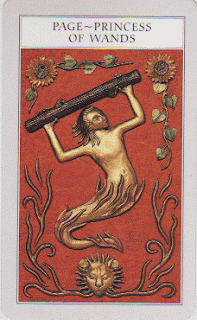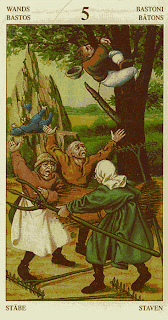Artist: Brian Froud
Author: Jessica MacBeth
"Office of Unclaimed Property, Hopes, and Wishes. Loyalty."
Oracle decks are different from tarot decks in a number of manners. There is no predetermined pattern to the deck. There is no
history of the cards. The cards are not used for games. Often, there are no "dark" images as there are in the tarot deck (i.e.: the devil, the tower, death, 10 of swords, 3 of swords, 4 of coins, etc.)
Oracle decks are similar to a 'book with all answers,' where opening a page answers your preset question. In this case, drawing a card tells you which page to open to.
Oracle decks often begin with the author's passionate
belief in one particular area. Some decks, as this one, marry existing imagery to suitable meanings. In general, these cards spring from a desire to tap
into the spiritual world to find "insight, wisdom, and joy," as is the purpose of this particular deck.
The author says,
Don't read someone else's definitions of the cards until you already have some idea of what they mean to you. This is good advice for any work of art, literature, poetry, graffiti, kitsch, tarot card, or ancient spiritual text. Don't let someone tell you what it means. Figure it out yourself,
then listen to others' opinions. You will gain no insight if you do not allow your inner eye to open. You will gain no wisdom if you always
only listen to the words of others— perhaps knowledge, but not wisdom. And joy?
What truly gives you joy?
Jessica MacBeth gives good instructions on how to get to know a card. In part, she asks a series of questions. She adds clarifying questions to help you think; I give no such help here. I summarize:
1) What is the emotional atmosphere of the card?
2) What might the physical manifestation of this card's symbols be in someone's life? What aspect of life does this card symbolize to you?
3) What do you see in the card's symbols that might represent the card's mental characteristics?
4) What are the spiritual characteristics of the card's symbols?
5) What do you find most appealing or comforting about this card?
6) What do you find most unappealing or uncomfortable about this card?
7) What other ideas or impressions do you have of this card?
And she says: if you fail to answer any of these questions, take a break until you can.
The following terms must be defined by
YOU: symbol, spiritual & mental characteristics, comforting & uncomfortable, appealing & unappealing. These are opinions and reflections of experience.
To me, this card looks like an old-man-puppy begging at the table. I used to love Froud when I was a little girl. I liked his dreamy images, the way he made pictures and I could daydream words. Now his language of pictures no longer speaks to me. That which I see in reality is more fantastic than any faerie he could ever dream. So to me, the card looks like an old-man-puppy and I want to tell it, "grow up." I will not let this deck "speak" to me.
There are a few things that could be happening. Among them are self-censorship, lack of interest in oracle decks, and refusal to assimilate anyone else's vision of faerie. Nonetheless, I will answer the list of questions.
The creature seems selfishly immature. It is wanting something, whining, trying to make me feel guilty if I do not give what it wishes. This beast has a certain slowness about it. It looks spiritually incomplete, grasping to the leadership of others. I find its wings appealing, because I like wings. I find the tilt of its head unappealing. It makes me want to wring its long neck, but the neck seems rubbery and I get the feeling that if I tried to choke it, the creature would laugh. I find myself fixated on wringing its un-wringable neck and hypnotized by its maniacal laughter into continuing on and on into insanity. It is frustrating. I come across as cruel and crazy—
but this is how we sometimes seem
in both reality and dream.



























